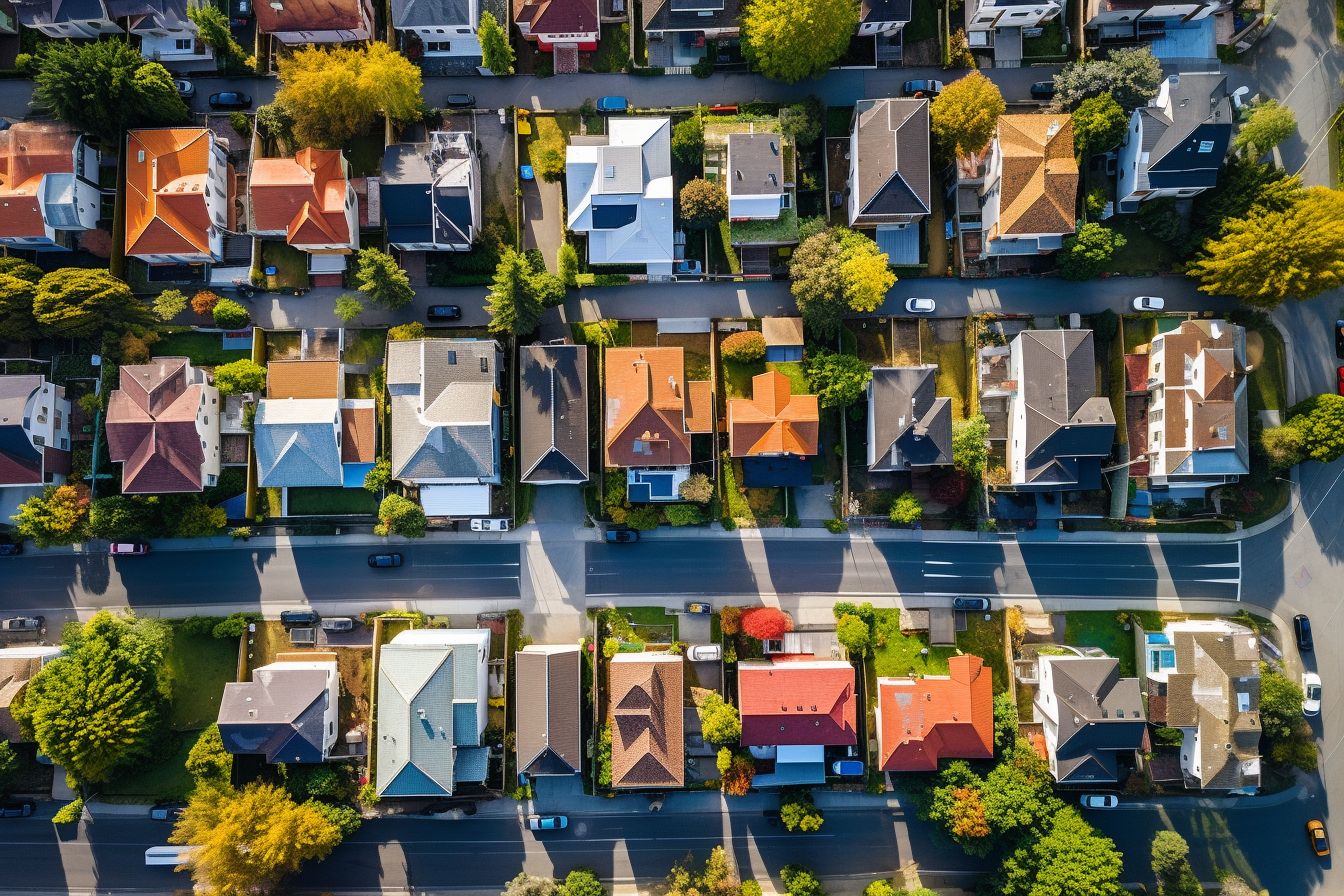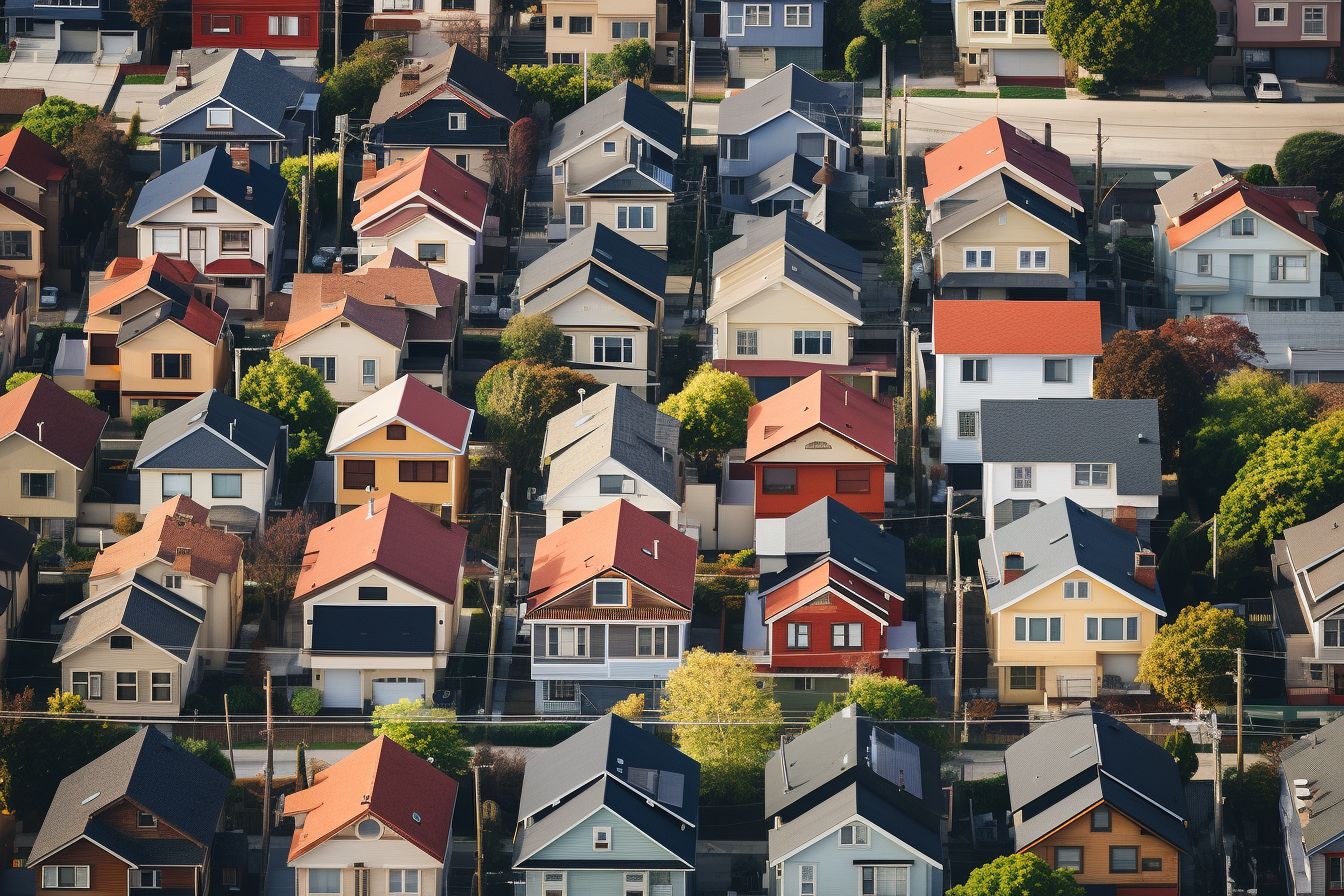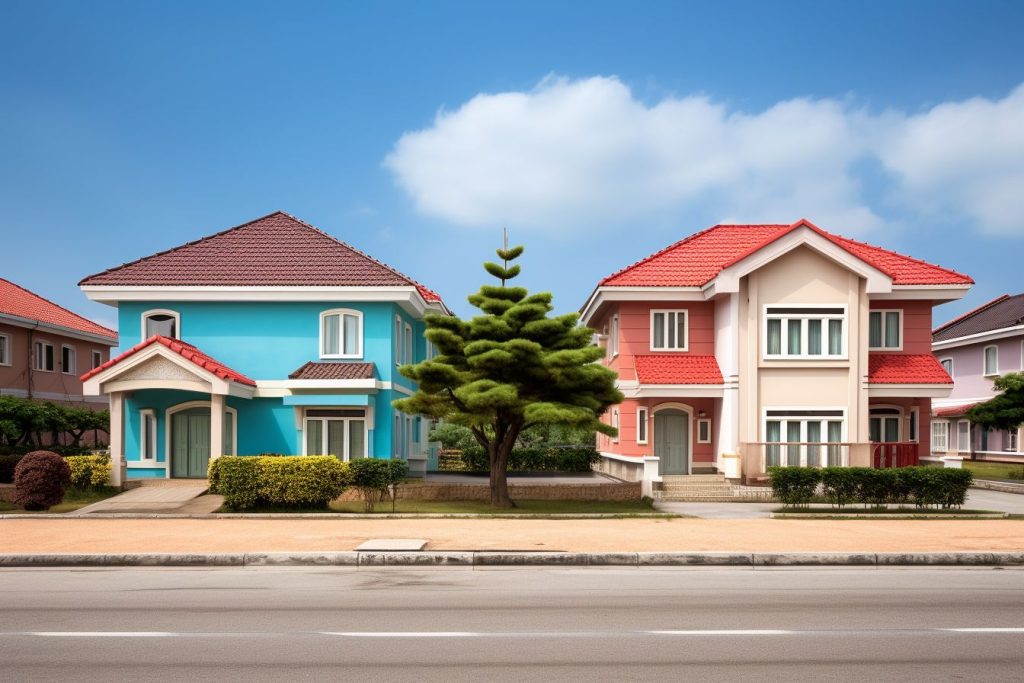Choosing the right roof colour for your home can seem daunting. With an array of colours to choose from and their significant impact on your property’s curb appeal, it’s no wonder many find this decision challenging.
This article offers you crucial insights into how best to select a roof colour that enhances both the aesthetic and resale value of your house. Keep reading; we will guide you to find the perfect shade for your rooftop!
Key Takeaways
- Consider your home’s architectural style when choosing a roof colour to enhance its unique characteristics.
- Coordinate the colour scheme of your siding and trim with the chosen roof colour for a harmonious aesthetic appeal.
- Choose a roof colour that blends well with your home’s natural environment, considering both aesthetics and energy efficiency.
- Use online visualization tools to experiment with different roof colours and make an informed decision before installation.
Factors to Consider When Choosing a Roof Color

Consider your home’s architectural style, the colour scheme of your siding and trim, the natural environment surrounding your home, concealing algae stains, and coordination with neighbouring homes.
Your home’s architectural style

The architectural style of your home plays a significant role in determining the appropriate roof colour. Whether your property reflects traditional architecture or features a more contemporary design, picking a shade that enhances its unique characteristics is vital.
A darker, neutral shingle colour harmonizes well with classic house styles, while modern homes may demand bolder roof hues for standout appeal. Coordinating the roofing material and siding colour is critical to achieving architectural harmony and pleasing exterior cohesion.
Ultimately, the right colour choice adds to the overall aesthetic appeal of your home by accentuating its exterior elements.
The colour scheme of your siding and trim
The colour scheme of your siding and trim works with the shade chosen for your rooftop. Selecting complementary hues creates harmonious interaction between different elements of your home’s exterior, establishing a pleasant aesthetic appeal.
Imagine white siding paired with grey, blue, or red roofs – it intelligently enhances the overall look.
Tan and brown houses generally lean towards roof colours that mirror their siding to maintain an equalized appearance. In contrast, yellow and red homes increasingly opt for neutral grey or black roofs as they offer a striking contrast while retaining sophistication.
Similarly, dark green or brown roofs go well with red sidings, setting a bold statement yet keeping a classic charm intact.
The natural environment surrounding your home
Overlooking the natural environment while picking a roof colour could lead to an aesthetically unappealing result. The choice of shingle colour should strike a harmonious blend with the natural landscape, ensuring that your home beautifully fits into its surroundings rather than sticking out oddly.
For example, houses in lush green areas might benefit from earthy tones or subtle greens, matching the forestry backdrop. Alternatively, homes located by the beach would look splendid, with light blue or sandy brown roofs reflecting seaside vibes.
Materials like asphalt shingles offer an appealing range of colours that can add depth and character to your exterior design while blending effortlessly with nature’s palette around you.
Moreover, this mindful selection is not purely about aesthetics; it also impacts energy efficiency and climate considerations. Strategically chosen roof colours in hot climates help maintain cooler indoor temperatures, enhancing energy efficiency.
Concealing the appearance of algae stains
Dark roof shingles can play a crucial role in concealing the appearance of algae stains. Black or grey roof colour options are particularly effective at this task. It’s not uncommon for roofs to develop streaks and spots over time due to algae or moss growth, especially in humid climates.
These darkly coloured roofing materials can aid in maintaining an unsullied look longer than other shades might allow. However, it remains imperative that homeowners prioritize regular maintenance and cleaning procedures to prevent damage caused by these stubborn organisms.
Coordination with neighbouring homes
Understanding the neighbourhood colour scheme plays a significant role in roof colour selection. When considering the dominant hues of your street or estate, your shingle choice can harmonize seamlessly with nearby houses.
You might also find valuable inspiration from neighboring roofs, helping you visualize how specific shades appear under local light conditions and against familiar backdrops. However, always adhere to guidelines or restrictions if your neighbourhood regulates certain aspects of exterior aesthetics, including roof colours.
Selecting a colour that matches well with surrounding homes not only enhances visual harmony but also preserves the collective curb appeal within your locale.
Tips for Choosing the Right Roof Color
Use online visualization tools, consider the climate and energy efficiency, seek professional advice, test the colour on a small section of your roof, and consider the long-term impact.
Use online visualization tools.
Leveraging online visualization tools can greatly aid in selecting the perfect roof colour. Here’s how:
- Online design tools provide a platform for homeowners to experiment with various roof colour options.
- With these, you can see a virtual image of your house sporting different colours, showing how each shade would look on your home.
- Tools like Owen Corning’s Design EyeQ® allow users to swap out numerous roof styles and colours on various house designs for visual reference.
- The Shingle Visualizer and Select Your Roof App are more useful platforms that enable viewers to change shingle colours virtually and assess the aesthetic impact.
- Such visualization tools ultimately enable better decision-making, enhancing curb appeal by ensuring a roofing colour that complements other elements of your home.
- Moreover, trying on different roof colours virtually eliminates the risk of dissatisfaction after installation, saving time and money in the long run.
- Use these platforms not just as decision-making tools but also as a source of inspiration when contemplating home exterior design changes.
Consider the climate and energy efficiency.
Choosing a roof colour that complements the climate can increase energy efficiency. Homes in warmer climates benefit from lighter colours due to their sunlight-reflecting properties, reducing attic heat absorption and cooling costs.
On the other hand, darker shingle colours are better suited for colder climates as they absorb more heat and aid in the temperature regulation of homes. A well-insulated attic can result in even greater energy savings by maintaining consistent indoor temperatures regardless of weather conditions outside.
Considering these factors when choosing a roof colour also contributes towards achieving warm or cool roof options that balance aesthetics with eco-friendly living.
Seek professional advice
Consultation with experts is crucial when choosing the right roof colour for your home. They can provide professional guidance based on their expertise and experience, ensuring that the selected colour harmonizes well with your house’s exterior.
Professionals can also help you consider weather conditions and environmental factors, ensuring that the chosen roof colour is optimal for your climate. Don’t hesitate to seek expert opinion to make an informed decision and enhance the overall aesthetic of your home.
Test the colour on a small section of your roof.
- Before finalizing your roof colour, testing it on a small section of your roof is important.
- This will give you a better idea of how the colour will look once applied to the entire roof.
- Testing the colour can help you determine if it complements the rest of your home’s exterior and works well with the surrounding environment.
- It also lets you see how the colour changes throughout the day as lighting conditions vary.
- By testing the colour on a small section, you can make an informed decision and ensure you are happy with the final result.
Consider the long-term impact.
Choosing the right roof colour is not just about the immediate visual appeal but also about considering its long-term impact on your home. The colour you choose can affect the lifespan and energy efficiency of your roof.
For example, lighter shades reflect more sunlight, keeping your attic cooler in hot climates and potentially reducing cooling costs. On the other hand, darker colours can absorb heat and benefit colder climates by helping to melt snow and ice.
Additionally, certain colours may fade or show wear more quickly over time, so it’s important to consider how well a particular shade will hold up over the years. By carefully considering the long-term impact of your roof colour selection, you can make a choice that looks great now and benefits you in the future by enhancing curb appeal and increasing resale value while minimizing maintenance needs and ensuring durability.
The Role of Roof Replacement in Choosing the Right Roof Color
Roof replacement is crucial in determining the right roof colour for your home. When making a first impression, the colour and style of your roofing shingles can have a significant impact.
That’s why it’s important to carefully consider your house’s colour scheme and choose a shingle colour that complements it. Additionally, the type and colour of your roofing material can even increase the value of your property.
To make an informed decision about roof colour, you can utilize the manufacturer’s website for initial selection and request sample shingles from your contractor that match your chosen colour.
By taking these steps during the roof replacement, you can ensure that you select a roof colour that enhances the overall aesthetics of your home.
In short, when choosing the right roof colour, don’t overlook the role of roof replacement. Consider how different colours will fit your home’s style and colour scheme and how they will affect potential buyers’ first impressions.
Remember to utilize resources like manufacturers’ websites and samples provided by contractors to help inform this important decision-making process. By considering all these factors during the roof replacement, you’ll be able to choose a roof colour that not only looks great but also enhances the overall appeal and value of your home without having to compromise on quality or functionality.
Popular Roof Colors and Their Effects

Popular roof colours can significantly impact your home’s overall look and feel. Dark grey or black roofs can give a slate tile appearance, while brown roofs provide a wood-shake look.
Lighter shades create a brighter aesthetic, beige or blue can complement certain siding colours, and natural wood offers a rustic appeal.
Dark grey or black for a slate tile look
Dark grey or black shingles are an excellent choice to achieve the natural appearance of slate roofing. These colours can also mimic the look of genuine wood shake, providing a sophisticated and classic aesthetic to your home.
In addition, dark grey or black shingles offer heat and cold resistance, making them a popular choice for homeowners who want durability alongside style. If you prefer a slightly lighter variation, consider dark grey or slate blue shingles for a softer look that still captures the sleekness of slate tiles.
Brown for a wood shake appearance
Brown is a popular colour choice when aiming for a wood-shake appearance on your roof. It is commonly used in homes with a rustic or traditional feel, as it brings warmth and richness to the overall aesthetic.
Brown asphalt shingles are often chosen for this purpose, but darker brown shades of standing seam metal roofing can achieve the desired effect. Not only does brown provide a natural and attractive look, but it can also make other colours in your home appear brighter and more vibrant.
Overall, brown roofs are dependable and offer a sense of simplicity while maintaining an attractive appeal.
Lighter shades for a brighter aesthetic
Lighter shades of roofing shingles are a popular choice for those who want to create a brighter aesthetic in their home. These light colours not only make buildings appear larger but also contribute to a sense of airiness and welcome.
In addition, lighter roofs have the advantage of reflecting sunlight, which can help keep the rooms beneath them cooler. When paired with neutrals like black or blues ranging from light to dark grey and dark blue, lighter shades of roofing shingles can enhance the overall look and feel of a building.
Furthermore, these light-coloured roofs can even play a role in reducing the urban heat island effect. So, to add brightness and style to your home’s exterior, consider lighter shades for your roof colour choice.
Beige or blue to complement certain siding colours
Neutrals like beige or warm tones like brown can be used as roof shingle colours to complement certain siding colours. If your home has cool-toned shingles like black or slate grey, consider choosing a cooler siding colour like blue to create a cohesive look.
On the other hand, if your siding is already a warm tone like beige or brown, opting for a neutral or warm roof colour will help create harmony in your overall exterior design. Beige roof shingles offer a relaxed and blended aesthetic when paired with similar-coloured exteriors, while blue siding can beautifully complement cool-toned roof shingles such as black or slate grey.
Natural wood for a rustic look
Wood shingles are popular for homeowners who want to create a rustic roof aesthetic. Wood shingles add warmth and character to any home with their natural materials and charming appearance.
The colour palette of wood shingles ranges from rich browns to weathered greys, allowing you to find the perfect shade that complements your exterior design. In addition to visual appeal, wood shingles are compatible with wooden structures, making them an ideal choice if you’re aiming for a traditional look.
So, if you want to enhance your home’s architectural charm and create a harmonious combination with nature, consider opting for natural wood shingles for a truly rustic look.
Conclusion
Choosing the right roof colour is an important decision that can greatly impact the overall aesthetics of your home. You can make a well-informed choice by considering factors such as your home’s architectural style, siding and trim colours, natural surroundings, and coordination with neighbouring homes.
Additionally, utilizing online visualization tools, seeking professional advice, and testing the colour on a small section of your roof can help ensure you select the perfect shade.
Take these tips into account to enhance your property’s curb appeal and value.
FAQs
1. What factors should I consider when choosing a roof colour?
When choosing a roof colour, you should consider the climate, the architectural style of your home, and any HOA or local regulations that may restrict certain colours.
2. How can I determine if a roof colour will complement my home’s exterior?
To determine if a roof colour will complement your home’s exterior, use online visualization tools or consult professionals for recommendations based on your home’s models and colours.
3. Will dark-coloured roofs make my home hotter?
Yes, generally speaking, dark-coloured roofs tend to absorb more heat from the sun and can result in higher indoor temperatures. However, proper insulation and ventilation can help mitigate this effect.
4. Can I change my roof colour without replacing the entire roof?
Yes, it is possible to change the appearance of your roof without replacing the entire structure by using specially formulated coatings or stains designed for roofing materials.
5. Are there any restrictions on roof colours imposed by homeowners’ unions (HOAs) or local regulations?
Some HOAs and local regulations may restrict acceptable roof colours to maintain neighbourhood aesthetics or preserve historical character. It is important to check these guidelines before deciding on a roof colour.

